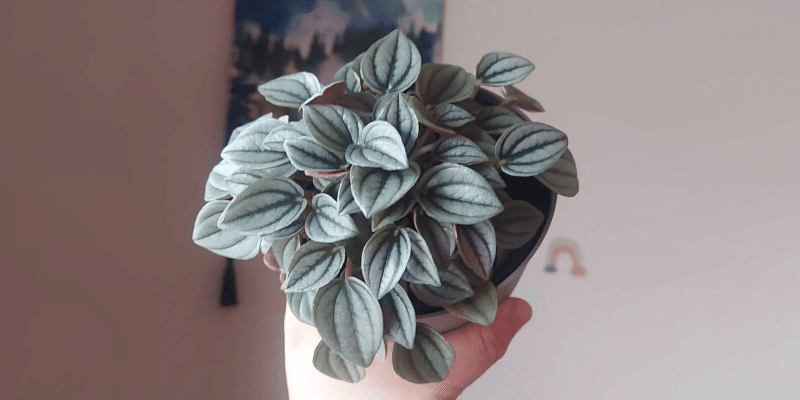In this care guide, we’re going to dive deep into one of our favorite genus of plants: Peperomia.
They aren’t always the easiest plants to take care of, and with 1600+ peperomia species, it can be a challenge to pick out the right one and know its particular care requirements.
So not only are we hoping to give you a really good basic knowledge of these plants, we’re also going to help you pick one out for yourself if you’re thinking about growing your first peperomia.
We’ll take you through the history and natural habitat of these tropical plants, cover the most common issues that come up, and at the end, answer the questions we hear the most.
Table of Contents
Peperomia Care Guide
History, habitat, and characteristics
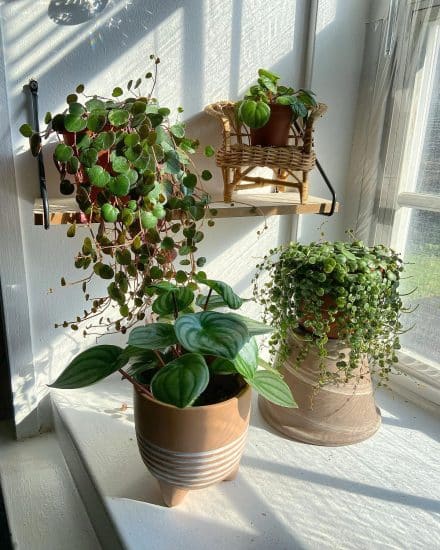
Peperomia plants are one of our favorite genera, with 1600+ species, and more being discovered every day.
There’s an incredible diversity to the Peperomia species you can find. From bright red stems, trailing heart-shaped leaves, or semi-succulents with their fleshy leaves, there’s something for everybody. But with this great variety comes some confusion about how to take care of these plants and really help them thrive indoors.
(The famous baby rubber plant and radiator plants? Both Peperomia!)
As Peperomia plants are tropical plants, their natural habitat is found just north and south of the equator. When we think of the tropics, heat, humidity, and rainforests often come to mind, but Peperomia plants are a bit trickier than that.
While we can find some growing in the southern United States, most are found in Asia, as well as Central and South America. They’re often nestled in smaller spaces, and if you were exploring or hiking through these environments, it might actually be a bit tricky to spot them.
In nature, Peperomia often grows epiphytically over other plants or in little nooks seeking out light where they can. Because of this, they’re often pretty small plants, and this makes them great as indoor plants.
(Even larger species of Peperomia plants, like Polybotra, don’t really get too large.)
The Peperomia plant genus is categorized based on how they flower, so you’ll notice what most of them have in common is their inflorescence. These flowers will look like small spikes or catkins, and some call them rat-tail-like flowers.
A few species, like Peperomia Paradoxa or Fraseri, do have different flowers. They’ll still have this telltale inflorescence but also spiky flowers that grow off of it, often parallel to the ground.
(If you want to skip ahead to any Peperomia care section in particular, just scroll to the top of this article and expand the table of contents. This will give you a quick way of finding exactly what you need.)
Peperomia species really break down into two categories, so let’s cover them now.
Succulent-like peperomia plants vs trailing peperomia plants

We can categorize Peperomia plants in a few ways, but for the sake of care, we’re going to pay close attention to their leaves and how they grow. You’ll notice some pictures of trailing varieties of peperomia as well as the semi-succulents.
Species like Graveolens, Dolabriformes, and Tetraphylla all feature hard succulent leaves. Succulents bring to mind a sandy desert environment, but this isn’t true for Peperomias. They may sometimes be in dry conditions, but often still under the canopy of a forest or hidden away in craggy rocks.
This makes them really easy to care for, because in nature, their conditions are so extreme: dry for weeks and then sudden rain. There are studies that show these succulent-like plants can be kept dry for months at a time and then recover just fine with watering after.
If you’re looking for a resilient plant that doesn’t require you to be on top of its care at all times, I’d stick to the thicker leaves of the semi-succulents at first.
Let’s explore their leaves a bit more.
If leaves look fuzzy, these fine hairs protect both from excessive sun (which hints that they’re going to be happier in indirect sunlight) and keep them from losing as much of their water. When plants transpire, water comes out from their leaves. These tiny hairs capture the moisture and keep it nearby, raising the local humidity and flowing back down to the plant.
Leaves with ridges will also tell us that these plants in nature are probably exposed to conditions where there’s sudden rain that needs to be funneled back into the soil.
If you look at species like Peperomia argyreia, Polybotrya, or Metallica, all have a sheen, a thin layer of waxy cuticle that helps keep the water in. All of these are strategies for maintaining water: hairs, ridges, and thick waxy cuticles.

These plants don’t really need bright sun like other succulents, which are found in the desert, and they’ll be happy in low to mid-humidity typically found indoors.
Peperomia verde and Watermelon peperomia (argyreia) are more succulent. The less-succulent plants, or Blanda, Jamesoniana, Cubensis, Clover cultivar, Rubella, and Fraseri all have thinner leaves and will need more humidity. They’ll want lots of diffuse light and to be watered more frequently.
In short: the waxier and thicker the leaf, the easier care is going to be for Peperomia plants.
Peperomia species

Now that we’ve given an overview of the Peperomia plant genus, we’ll cover some of the most popular Peperomia species and their unique characteristics.
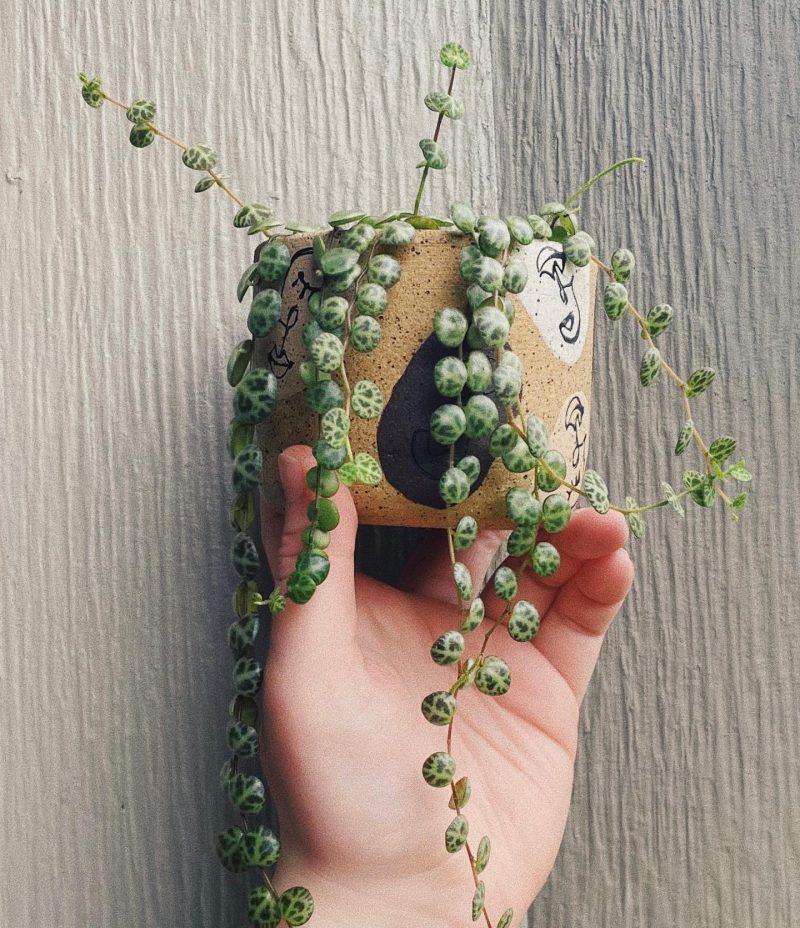
String of Turtles, Peperomia prostrata, is a trailing plant native to Brazil. It has small, round green leaves with silver stripes, giving it a unique appearance that resembles the pattern on a turtle’s shell. Looks amazing in hanging baskets or trailing down a bookshelf. One of my favorite Peperomia.
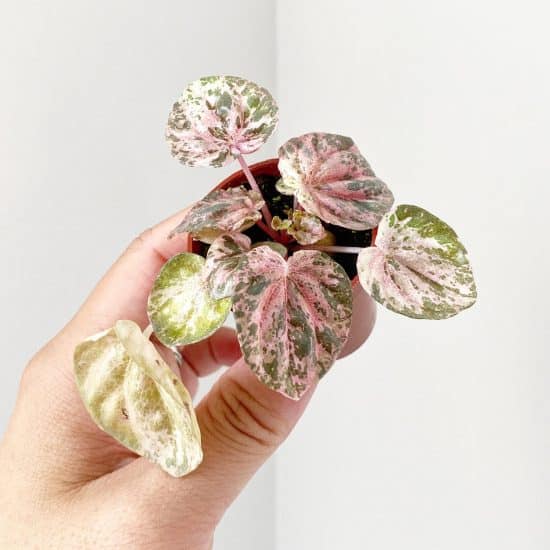
Peperomia Caperata (Ripple Peperomia) is a small, bushy plant with heart-shaped, waxy grooved leaves. Featured above is one of its many variegated varieties. More are being developed every year, with four patents granted this year alone!
Peperomia Hope (Peperomia tetraphylla) is a semi-succulent with characteristic coin-shaped leaves, produced as a hybrid of Peperomia deppeana and Peperomia quadrifolia.

Raindrop Peperomia (Peperomia polybotrya) has lovely coin-shaped leaves that are quite pest resistant, thanks to their thick waxy cuticle. Rarely flowers indoors and incredibly easy to care for.
Peperomia Prostrata is a small, trailing plant that is semi-succulent, which means that it stores water in its leaves and can tolerate some periods of drought. It has small, round leaves that are green with silver stripes.

Peperomia Obtusifolia, also known as the Baby Rubber Plant, is a small, bushy plant that is native to Central and South America. It has glossy, rounded leaves that are a deep green color and can grow up to 10 inches tall. This plant is a popular choice for beginner indoor plant enthusiasts, as it is easy to care for and can thrive in a variety of indoor environments.
Cupid Peperomia a small, bushy Peperomia with cute heart-shaped leaves. Leaves are typically a frosty green with yellow borders.

Watermelon Peperomia is a semi-succulent plant native to South America. It has thick, fleshy leaves that are green with a watermelon-like pattern of stripes and spots. This plant prefers bright, indirect light and a well-draining potting mix, making it an excellent choice for a sunny windowsill.
Peperomia Rosso (Peperomia caperata ‘Rosso’) is a semi-succulent species with beautiful deep velvet leaves and bright red highlights. Very dramatic and loves light.
Peperomia Frost (Peperomia caperata ‘Frost’) comes from the same species as ‘Rosso’ but with a dramatic, chilly look. This plant has striking foliage that is green with a silver sheen and white edges, giving it a frosty appearance.
Now that you know a bit about their history and categories, let’s get right into how to care for a Peperomia.
Light
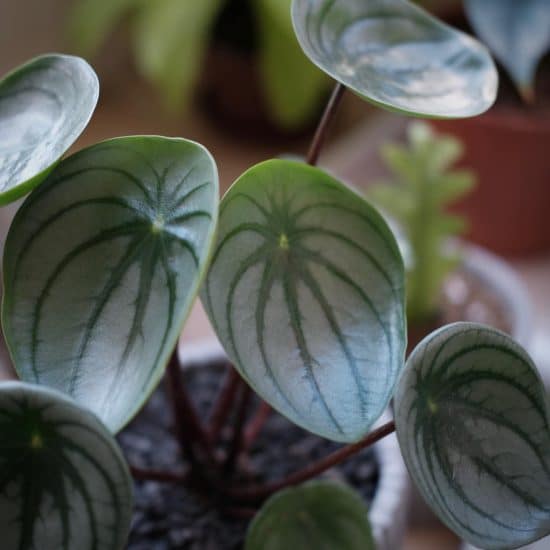
Peperomia plants can thrive under a diversity of lighting conditions, but throughout the Peperomia genus, they have a few things in common: they like brighter light and don’t do well under direct sun for too long.
Lighting for the Peperomia genus will depend entirely upon the leaves of your species, but either way, the best conditions will be lots of bright, indirect light.
Too much sunlight and you’ll see leaf burn and crispy spots where the direct sunlight is burning the leaf. We suggest avoiding south-facing windows unless you’re in a location that receives filtered light, your window has curtains, or the plant is at least a few feet away.
Lower light and you’ll notice a loss of variegation in the species that have it, drooping leaves, and very slow-growing plants (if they grow at all).
Peperomia lighting tips:
- Provide your plant with bright indirect light, a few feet away from a window.
- Direct sunlight will result in burnt leaves and can make those leaves more accessible to disease and pests. No direct sunlight (yup, even for the semi-succulents).
- If you have low light in your home or if indirect light is at a premium, you can consider a grow light. You’ll want one that’s full-spectrum LED and kept around a foot away so that the plant isn’t burned by any heat that’s generated. Since these are a great deal cooler than direct light, you don’t need to filter it at all.
Water

When you read that Peperomia plants are tropical succulents, you may think they don’t really need a lot of water. Well, be reassured that your instinct is right!
With the semi-succulent species of Peperomia plant, you can really squeeze the leaves to feel how plump and firm they are. If they’re feeling flimsy and like they could be easily folded over, it’s time for some water. If they really resist movement and seem firm, you’ll want to wait a bit longer, even if the soil feels mostly dry.
Just make sure to perform this test on a mature leaf, as younger leaves can be a bit misleading because they haven’t developed yet.
If you are worried about overhandling your plant, you can use the reliable finger in the soil test. If it’s dry 2 inches down, feel free to give your plant some water.
Overwatering is a real risk with many indoor plants, and Peperomia is no different. If this plant sits in wet soil for too long, it can rot, and this will be a fast end to your plant.
But it’s not just too much water your peperomia needs to worry about. You should also be on the lookout for signs of underwatering, including wilting, limp leaves, flower buds falling off, and lighter foliage coloring.
A watering schedule will always depend on the soil and the environment around your Peperomia plant. As long as you keep an eye on the soil and avoid soaking the plant, you’ll have a beautiful and healthy potted friend in no time.
Temperature and humidity

Maintaining the right temperature and humidity is essential to keeping your Peperomia plant happy, healthy, and thriving.
Household humidity is fine for almost all peperomia plants, but if you’re buying a specialty plant or from a terrarium grower, you’ll likely need a glass enclosure or bell jar because these will really need high, rainforest-levels of humidity that we can’t really get in other ways indoors.
For healthy growth, the temperature should be kept between 65-75°F. Make sure that the peperomia are not near any air vents, drafts, or cold windows – unless you want to give them the cold shoulder.
If you do need to raise your humidity, you can:
- Place your Peperomia pot on top of a tray filled with stones. Fill up the tray with water and it will evaporate, providing an extra 4-5% humidity – without leaving your entire house feeling like a sauna. Steer clear of misting them with water, since this will help avoid uninvited mold and diseases.
- Choose a naturally humid environment such as a terrarium or group your houseplants together to increase humidity.
- Place plants that need more humidity in a bathroom, as long as it does get a fair amount of indirect sunlight.
Soil and planting
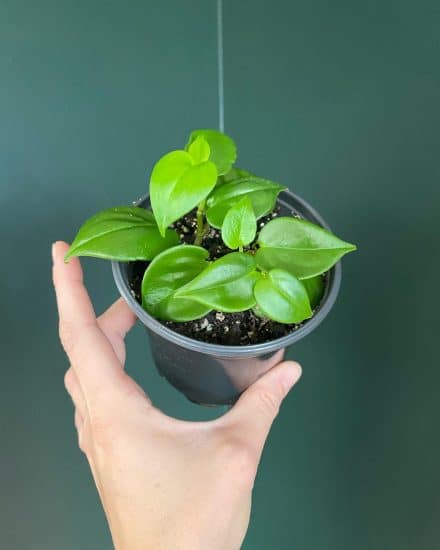
Soil and potting are the most important parts of Peperomia plant care and where many people make a mistake, especially if it’s their first plant.
When you first get it home, what do you want to do? For many houseplant owners, get it out of that nursery planter and into a new decorative pot.
Nope!
You’ll want to leave new plants in the nursery planter they came in for at least a full growing season.
So what about a pretty pot? You don’t need to replant, just double pot and use what’s known as a cache pot. When you water, just make sure you take it out and it’s given a chance to drain so that your exterior pot doesn’t fill with water.
For soil, we recommend a mix of cactus soil, perlite, and a bit of added bark. You really want to avoid anything that’s peat-heavy where the water wants to just stay in the soil. If you do have soil rich in peat moss, just add more perlite to avoid soggy soil.
Peperomia stay small and are epiphytic, which means they don’t mind being a bit root-bound. You’re unlikely to see roots coming out of the holes of a planter pot, but if you do notice this, it could be a sign to repot your plant if you’ve had it for a while.
With semi-succulent Peperomia, you can really leave them in their planters for a long time. Like… 4+ years.
Trailing varieties of peperomia do love to be repotted, so consider doing this after the first year.
(The best part of small planters is they don’t really take up too much space – just make sure they have drainage holes.)
With most plants, you’ll want to water them after repotting, but with the semi-succulent species, you can skip it completely. Also, only consider repotting peperomia plants when they’re dry. You should always wait that extra couple of days unless you really need to rescue a plant.
Propagation guide

If you accidentally knock a leaf off from many varieties of trailing peperomia plants, you might notice a small petiole still attached, where the leaf attaches to the stem. if so, just plant it in some moist soil, and you’ve propagated your plant!
In nature, Peperomia often pollinates through wind or self-fertilization, but this is a bit tricky for most indoor gardeners, so we’ll stick to taking a cutting/clone.
Propagating peperomia plants through leaf cuttings
We’re going to take a leaf cutting and plant it directly in the soil, so all you need to get started is:
- Small pot with the potting soil mix we suggest above
- Healthy Peperomia plant in the growing season
- Sterilized shears or a knife
Let’s go!
- We’re going to cut off a leaf with a bit of its petiole still attached, the tiny segment that connects the leaf to the stem. We want this petiole because that’s where we’re going to create roots.
- Place your cutting in the soil mix and water it thoroughly. You can even place a cluster of them in here to make a few clones at once from the mother plant.
- Cover the soil with a plastic bag, a cut 2-liter bottle, or a glass bell jar to keep that humidity up for the next few weeks. We want all the moisture we can get and plenty of indirect sunlight.
In 3-5 weeks, you’ll have a healthy root system developing, and you can either transplant into a larger container or keep them where they are. Try to avoid pulling at them too much before that, as this can disrupt the growing root system.
We do prefer this to the stem-cutting method, but propagating in water if you already know how works great too, especially if you want to watch those roots develop.
Common issues
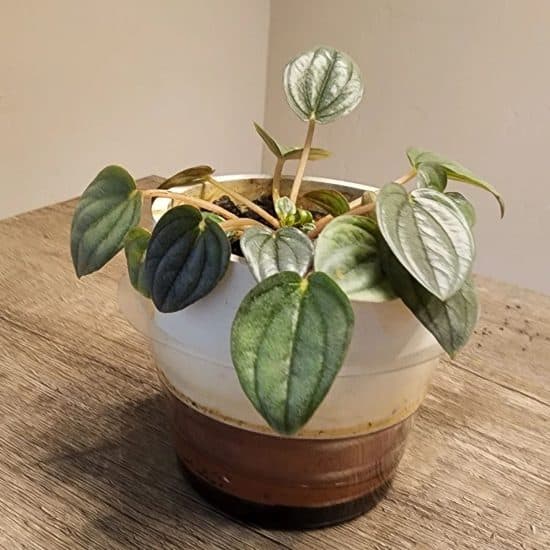
Because there’s so much diversity in Peperomia plants, we’ll cover the issues common to most.
Leaf Drop
Leaf drop is a common occurrence for Peperomia plants. Your plant is likely to shed lower, older leaves as it focuses its energy on growing new foliage, and this should not be cause for concern. Consider this a sign of normal growth, and let your plant focus its resources on healthier growth.
If you see your Peperomia dropping leaves that are young and mature, this is cause for some curiosity. If you recently purchased it, it’s possible that a change in environment or temperature has shocked it. If you repotted it, this also could be a factor. Leaf drop can also be caused by overwatering; take extra care to ensure the soil is neither too moist nor too dry with regular moisture content tests.
Yellowing leaves
If you’re under or overwatering your Peperomia plants, it’s likely you’re going to see some leaf yellowing.
If underwatered: the leaves will droop, look a bit withered, and have crispy yellowish-brown edges/tips.
Overwatering often appears as yellow leaves and stems that look weak. The leaves will also be a bit firm, and you might even notice water transpiring out.
If you catch this early, great! Let that soil dry out and back off of the watering. If not ,you might experience root rot, which we’ll cover how to fix in the next section.
Diseases and pests

Peperomia, especially the waxier succulent types, are pretty hardy and pest-resistant. Often, though, pests are so hard to see that they may already be on your plant upon arrival, and most soil does harbor fungus that becomes activated with excessive moisture.
The best way to treat both of these is with an application of neem oil and soapy water every 3-4 months. Make sure that soil dries out between watering, and don’t mist your plant’s leaves. If you do, make sure they’re dried off after.

Root Rot: This is a common issue with over-watering indoor houseplants and can be identified by looking at the roots. If they are slimy, mushy, or discolored, then the root rot has begun to affect the plant. To remedy this issue, cut away any affected roots and repot the plant using fresh, aerated soil. Make sure to allow the soil to dry out thoroughly between each watering.
Bugs: Peperomia plants are resistant to most pests, but a weakened plant can still be attractive to spider mites and mealybugs. Keep an eye out for puffs of cotton, sap, or webbing underneath the leaves. If you notice them, wipe the plant off with soapy water or alcohol and then start treating it with neem oil every few weeks.
Pest damage in Peperomia will often primarily affect the middle of a leaf, and often the younger leaves on the plant.
Conclusion

We hope you enjoyed our Peperomia journey! You should now know how to care for a peperomia, even if you aren’t sure of the exact species or cultivar.
Remember: those leaves are going to tell you so much about the care they want, and fortunately, most of the other requirements are going to stay the same.
Let’s recap.
Peperomia plants prefer:
- A well-draining potting soil
- Medium to bright indirect light
- Letting the soil dry out between waterings
- A smaller pot, making sure that it has plenty of drainage holes
If you love indoor gardening and want to stay in touch, please follow us on Twitter and Facebook to stay up to date on all of our articles and for notifications on the latest varieties and species being cultivated and discovered.
If this article helped you grow Peperomia or gave you some useful information, please consider sharing it with a friend.
Take care!
FAQ
Do Peperomia clean the air?
They don’t quite have the same reputation for air-filtering that other plants do, althoguh they have been proven in B.C. Wolverton’s NASA study to remove many VOCs from the air.
Are peperomia true succulents?
Peperomia plants are often called “semi-succulents” because they have thick, fleshy leaves that store water, but they do not have the same water-storing capabilities as true succulents. Their natural environments also differ significantly, so you’ll want to use a mixture of cactus/potting mix for these plants.
Should you mist peperomia?
It’s better to not mist your Peperomia, as this can increase the risk of fungal disease and other pest problems. If you do mist, wipe those leaves off after. There are better ways of increasing humidity, like grouping plants, a pebble tray, or even a small humidifier.
Are Peperomia the same as the baby rubber plant?
“Baby rubber plant” is a common nickname for Peperomia obtusifolia, a pretty popular Peperomia species, but it’s also sometimes used to describe any of the 1,500+ species of Peperomia. Rubber Plant and Radiator Plant are both pretty generic nicknames, so you can’t always be sure by that alone what they’re referring to.
Can you propagate peperomia from stem cuttings?
Yes, peperomia can be propagated from stem cuttings. To do so, simply cut a stem with a few leaves and plant it in moist soil or water. We prefer using leaf cuttings, but both work great.
Do peperomia grow fast?
Peperomia plants are not fast growers and won’t take over your space too quickly.
Do you need to give peperomia plant food or fertilizer?
Peperomia plants do benefit from occasional fertilizer, but they are not heavy feeders. You can use a balanced, water-soluble fertilizer once a month during the growing season (spring and summer). Be sure to dilute the fertilizer to half or quarter strength to avoid leaf burn.
Are peperomia flowering plants?
Yes, some varieties of Peperomia produce small flowers on thin stems. The flowers are not the main attraction of the plant, however, as the leaves are the real star of the show.
Are peperomia plants difficult to care for?
Peperomia care really depends on which variety you have, but it can be a bit difficult.
I think it’s important that you really understand how a plant grows throughout the year. Peperomia plants will get a lot easier to take care of once you’ve been through a full growing season with any first houseplant. They aren’t very difficult, there’s just a few tricky parts.
Are Peperomia toxic to pets?
According to the ASPCA, many Peperomia are non-toxic to cats and dogs, but you’ll want to look up your specific species.

